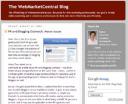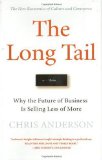When Google Penalizes You – Robin Good’s MasterNewMedia Story
 Last week, Robin Good of MasterNewMedia suddenly experienced a drop of incoming traffic. As an indepedent online publisher, Robin relies on organic searches (primarily Google) for his business. Unbenownst to him, his site somehow ran afoul of the Google’s guidelines, and his research via Google’s Webmaster Central yielded some clues to why his site was penalized by Google.
Last week, Robin Good of MasterNewMedia suddenly experienced a drop of incoming traffic. As an indepedent online publisher, Robin relies on organic searches (primarily Google) for his business. Unbenownst to him, his site somehow ran afoul of the Google’s guidelines, and his research via Google’s Webmaster Central yielded some clues to why his site was penalized by Google.
According to ComScore, Google has nearly 50% of the search market share as of May 2007 of this year. If you inadvertently do something that goes against Google’s policies, you could lose a significant portion of your audience. And if traffic to the blog is how you are measuring success to your client, then how do you manage this?
I strongly advise any PR practictioner advising clients on blogs to read the full story – Google Nightmare is Over. Links to the series of articles are located at the bottom of this posting.
The Value of LinkedIn Answers?
Social networking sites are extremely popular, receiving a lot of attention in the press. From my perspective, LinkedIn is different from other social networking sites, such as Facebook, MySpace or Reunion (disclosure: my good friend works at Reunion), in that the purpose is busines related. There are other bloggers who have focused on how to measure social media, most notably KD Paine’s PR Measurement Blog. My goal is to specifically look at how LinkedIn Answers can provide measureable impact, especially from a business-to-business perspective.
In terms of measuring the impact of participating – this is where coordinating with your marketing department will be key.
1. How many people were referred to your site from LinkedIn?
2. Did an incoming sales prospect reference the site?
3. If you included links to a page on your site, how many clicks did it get from LinkedIn?
4. And if you decide to include your contact info, did someone contact you as a result of the contact info?
And of course, it’s a great way to get your “community” to help with research , such as services, resources, and other expertise.
I would love to hear if anyone experienced direct benefit from LinkedIn.
PR and Blogging Outreach – Macro Issues
 My guest post on “PR and Blogging Outreach – Macro Issues” has just appeared on Tom Pick’s WebMarketCentral Blog. In a two part series, I look at how blogging is impacting the PR industry and how PR professionals pitch bloggers.Issues that I address in this first posting are 1) multigenerational workforce, 2) focus on results, not quality, and 3) how agency structures promotes billing, not client service.
My guest post on “PR and Blogging Outreach – Macro Issues” has just appeared on Tom Pick’s WebMarketCentral Blog. In a two part series, I look at how blogging is impacting the PR industry and how PR professionals pitch bloggers.Issues that I address in this first posting are 1) multigenerational workforce, 2) focus on results, not quality, and 3) how agency structures promotes billing, not client service.
Look forward to hearing what you think.
Social Tagging – PR or Marketing?
Tom Pick, B2B marketing expert and author of The WebMarketCentral Blog, wrote a great series of posts about social tagging. I’ve included links to his comprehensive look at how social tagging can help drive B2B traffic below. Instead of repeating Tom’s excellent work, my question is who’s responsible for social tagging – PR or Marketing?
I guess it depends on the resources of your client. For a company with a full marketing department, this work may fall to the person responsibel for search engine optimization/search engine marketing (SEO/SEM). This person is responsible for establishing programs that drive the organic traffic to your website.
From my perspective, social tagging should also fall on this person’s plate. If a company doesn’t have someone focusing on SEO/SEM, then this is a possible opportunity for PR. Like all PR, social tagging must be done strategically and methodically. And from Tom’s work, valuated over a period of 2 – 3 months. Couple of things that come to mind:
1. Track what you’re tagging and to map out the timeline. Whether you’re working with your client or have access to analytic information, reviewing traffic patterns to these specific pages will be one way to measure the effectiveness of your program.
2. Without understanding the different social tagging sites (at least for now!), let’s assume that other people can also bookmark your links. If this is possible, then consider getting updates with each new bookmark through something like google reader. For example, I get updates each time our website is bookmarked by someone on del.icio.us.
And me? I guess I’ll start with a couple of pages, see what happens and go from there.
Source – Tom Pick’s The WebMarketCentral Blog, Social Tagging Series:
- Part 1: Alexa Rankings
- Part 2: The Worst
- Part 3: Specal-Purpose Sites
- Part 4: B2B Traffic Building
- Part 5: Tier 3 Sites
- Part 6: Tier 2 Sites
UPDATE: I forgot one more: Part 7: The Best
Measuring PR: The Quick and Easy Way
I was reading an article in PR News on what success looks like based on one’s client and goals. This article got me thinking about the types of measurement that is near and dear to my heart.
I know there is discussion about using formulas to determine the value of PR based on advertising values or other methods to determine share of voice. Granted, I think this is worthwhile for a larger corporation. But as a start-up company, doing more detailed analysis is overkill.
Frankly, CEOs just want the basics and my time – like yours – is valuable. I don’t recommend including articles resulting from news release distribution. I don’t do an analysis of voice or messages as the volume is manageable. And if I were to provide this report on a regular basis, I need a quick and easy way to input and maintain this information (see excel sheet below). Overall, I provide three key statistics: total number of articles, features vs. mentions and circulation numbers.
1) Total Number of Articles: This provides an easy base for measurement. I can compare the volume from a month-to-month basis, and eventually, year-over year.
2) Features vs. Mentions: I do believe it’s important to separate when an article focuses on an announcement versus a mention. This provides a sense of how well you’re placing articles about your news, reports and case studies. As this program develops and more reporters become familiar with your company, I would expect the number of mentions to increase.
3) Circulation Numbers: I recommend using BPA audited circulation numbers where available. Otherwise, I’ll recommend taking the average number of site visitors or subscriber base number listed in the media kit. To me, this is the easiest number to use regarding the possible reach of an article. Again, it’s not about accurately determining the value of PR, it’s providing a baseline for your executive.
4) Tracking PR to Marketing: In a previous post on my friend’s blog, I had mentioned other ways to track PR. Though this may not be a regular component of your reporting, consider providing the number of clicks or conversions resulting from PR placements when available.
In the end of the day, getting positive media coverage is more important to me then spending too much time on measuring and justifying PR. If you have to resort to spending hours creating weekly status reports and complicated measurements to convince me of your value, then you’ve missed the point!
I would love to hear any other quick and easy ways to measure PR.
Seed Words Make Your PR Flower
In my previous post, Search and Find – SEO Your Press Release, I mentioned how keywords play an integral role in your press releases. Since that post, I’ve learned more about how to find these keywords and determine the effectiveness of these keywords for PR.
There are several tools out there to help research keywords. Since we use Wordtracker, I’m going to show the steps from this software.
1. Research Seed Words: To build a relevant set of keywords, start with a general list of seed words. These are general terms that you think are relevant from a search perspective. For example, I did a search on “public relations,” getting 100 results with the most searched terms at top. Though the public relations term came back with a healthy number of results, some searches may yield little or no results. When this happens, continue to expand your universe of seed words until you come back with a healthy return.
2. Review the Results: Review the list of words to determine the number of current searches and predicted number of searches on that term per day. If the results are too vague, you can begin narrowing the search term to variations of the word, such as PR, media relations, etc. However, be careful of narrowing your search too much as you may limit the possibilities.
3. Competition for Keywords: Once you have one set of terms,you’ll want to know how many pages compete for these words on Google, Yahoo and MSN. For example, using public relations would be very competitive with over 111 million pages. However, “health public relations” yields only 13,500 pages.
4. Research, Evaluate, Research: As with everything I’m learning about SEO/SEM, it’s all about research, evaluate and research again.
And for you tech pr folk out there, “technology public relations” was not in the top 100 searches for “public relations.” Something to think about for those technology PR agencies out there. Will I find you if I need a tech agency?
Tracking RSS Feeds
Many companies have RSS feeds for company updates, as this provides people another way to stay up-to-date on your company news and press releases without having to come to the website every other day. Though it’s important to syndicate/distribute news via RSS, you also have to track RSS feeds this as well.
Why? Because if you’re successful in having people subscribe to the feeds, theoretically the site traffic numbers may decrease. From a marketing perspective, if you experience a dip in traffic, you need to demonstrate that subscriptions to your feeds were increasing. Furthermore, this provides you feedback on what content resonates with your audience.
Researching this intriguing question, here is what I found out – some are more laborous than others:
1. Check the server logs: If a request is made, then this is logged on the server. However, RSS feeds are not representative of a person requesting the information , but rather how you set up the feeds to refresh the information. So this may skew the information even if you didn’t look at your feed for weeks.
2. Request an email: You can request an email to track the RSS feed. Though you can track who is subscribing, I believe that anonymity is key for incorporating RSS feeds.
3. Give each subscriber an unique identifier: There are different ways to track unique users but I recommend reading posts on Ask Leo and ongoing as they provide in-depth information on the various ways. Much better than I can.
4. Use an RSS Aggregator: In the end, I like the idea of using FeedBurner to track RSS feeds. It provides a convenient way to view all of your feeds, site numbers and additional options for optimizing your feeds for SEO.
I’m still learning about FeedBurner and will provide a follow-up post on how to best set up the RSS feed. Please leave me a comment if you have any advice/tips & tricks for optimizing RSS feeds.
About
Favorite Service
Recent Comments
- on Going Virtual Isn’t Necessarily the Answer to Replacing Your Physical Events
- on Going Virtual Isn’t Necessarily the Answer to Replacing Your Physical Events
- on Going Virtual Isn’t Necessarily the Answer to Replacing Your Physical Events
- on Going Virtual Isn’t Necessarily the Answer to Replacing Your Physical Events
- on Going Virtual Isn’t Necessarily the Answer to Replacing Your Physical Events
Ads by Google
Favorite Books
Marketing Blogs
PR Blogs
- KD Paine's Measurement Blog
- Micro Persuasion
Virtual Events & Meetings Blogs
- Cisco Virtual Environments
- It's All Virtual
- The Webinar Blog
- Virtual Edge Institute

 Follow
Follow Cece Salomon-Lee is director of product marketing for Lanyon Solutions, Inc. and author of PR Meets Marketing, which explores the intersection of public relations, marketing, and social media.
Cece Salomon-Lee is director of product marketing for Lanyon Solutions, Inc. and author of PR Meets Marketing, which explores the intersection of public relations, marketing, and social media. 


